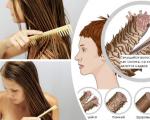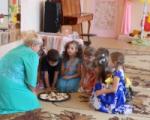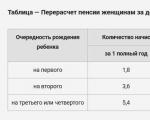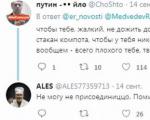Children's dress "angel feather". Incomparable crochet children's dress*Angel Feather*MK Pink crochet dress with angel feather pattern
Yoke (you can knit any other one that you like best)
Ribbon lace pattern for a skirt.
I will knit a yoke and a skirt made of ribbon lace separately, but you can immediately tie ribbons to the yoke... how to do this is well shown in the online adult dress (link above)
This is roughly how it should work out for us
MK knitting ribbon lace:
1. We dial 13th century. in and close the loop of the air chain into the ring at 8 (in the diagram it’s a little different, there the loop of the air chain is closed into the 7th loop), 7 v remain free. P.
2. Knit 7th century. n and close them in the first loop of the beginning of knitting.
3. Turn the knitting over. We knit 7th century. n, then into the formed ring of the previous row we knit 10 C1H, between the columns 1 in. P.
4. 7th century again n and close the knitting.
5. Turn the knitting over. Chain of 7c. p. we tie 10 RLS, then in the air. loop between C1H of the previous row, knit 1СБН, arch from 3 in. p, 1 RLS and 4 such arches
6. In the 5th century. p. between C1H of the previous row we knit RLS and repeat the previous feather
7. Since I haven’t connected further yet, I’m posting a photo of MK from a foreign magazine.
We knit the feathers to the required length of the dress, we tie the last feather with arches all over, and not half, as in the previous ones, we get 9 arches and begin to tie the second side of the ribbon strip in the same way
We break the thread and begin knitting the second strip of ribbon lace.
8. While knitting the second strip, we connect the feathers in the first arch from 3c. n with the same arch of the previous row (this is clearly visible in the main diagram)
9. To expand the skirt, we make two from one feather; for this, in the previous row, in the place of the intended expansion, we need to tie into a ring not 10 C1H, but 11 C1H.
Well, let’s not worry about this for now,... then we’ll think specifically about how to do it correctly.
In the meantime, let's start knitting a yoke.
I have threads ANNA 16 -530/100g, hook No. 1.5.
I advise you to take a yarn that is not very soft, so that the skirt fits well and does not look like a rag.
My baby is 2.5 years old.
I don’t have the opportunity to try anything on it now, so I knit it by applying it to a knitted blouse.
I cast on 156 loops. I distributed the loops like this.
For beginners, this video will help you learn how to correctly calculate the loops for a square yoke.
Start knitting
The coquette is tied. We tie the RLS yoke along the edge to the back wall.
On the wrong side there should be loops from the pigtail, they are marked with a white tick.
Then we will continue knitting this particular braid.
We begin to tie the edge of the yoke with feathers.
The distance between the feathers is 6 sc stitches.
We connect the feathers together behind the first arch.
The yoke is tied. I immediately knitted chain stitches for buttons at the back.
I turn the yoke inside out and using the braid that I got when tying the sc on the back wall, I begin to knit 2 more rows of the yoke (you can knit any number of rows you need), making increases along the edges.
But!!! I knit only the front and back, I don’t touch the sleeves.
Now I connect both knitted halves of the yoke next to the sc.
To reach the desired width of the breast (mine is 56 cm), between the back and the breast (under the armpit), I knit a few more chain stitches, then I tie everything with the second row of sc.
If you are satisfied with the resulting width of the breast, then c. n. are not needed.
Here's what I got.
I put the yoke aside for now.
I'm starting to knit strips of ribbon lace for a skirt.
I repeat, my skirt will be knitted separately.
Those who don’t want to bother can immediately tie the ribbons to the yoke.
You can see how to do this in the online adult dress on the second page (link given above). Although, I think there is no need to look, those who have already tied the yoke with feathers in a circle probably understand the essence.
So far I have knitted 2 pieces. two stripes each. There are 9 feathers in a strip (this is the length I need)
I'm starting to expand. I decided to do it every 3 rows of strips.
I knit the third row and in the 4th, from the beginning of knitting the feather, I make a circle not 10 C1H, but 11 C1H.
11 C1H make stripes in only one feather!!!
Then I tie the feathers to the end of the row, start tying the other side of the strip to the feather where we have 11 C1H. I move to the next arch (marked with a circle in the photo) and start knitting 5 feathers downwards. Then I tie it on the other side as usual.
The skirt is knitted. On the top (on the chest) I got -20 feathers, on the bottom - 27 feathers.
7 extra feathers gave a slight expansion towards the bottom.
For those who have not yet knitted a skirt, my advice is to make the length of the feathers longer (by about 1 feather) than planned, since this pattern gives very strong compression.
It’s good that I knitted the feathers separately from the yoke and now I have the opportunity to add a feather on top to get the length I needed, because the skirt turned out to be a little short
I connect the skirt with the yoke RLS
Children's dress "Angel Feather" crocheted. Master class from NINASOKOL - "COUNTRY OF MOMS".

Start knitting
Well, let’s not worry about this for now,... then we’ll think specifically about how to do it correctly.
In the meantime, let's start knitting a yoke.
I have threads ANNA 16 -530/100g, hook No. 1.5.
I advise you to take a yarn that is not very soft, so that the skirt fits well and does not look like a rag.


The coquette is tied. Along the edge we tie the yoke sc back wall.
On the wrong side there should be loops from the pigtail, they are marked with a white tick.
Then we will continue knitting this particular braid.

We begin to tie the edge of the yoke with feathers.
The distance between the feathers is 6 sc stitches.
We connect the feathers together behind the first arch.

The yoke is tied. I immediately knitted chain stitches for buttons at the back.


I turn the yoke inside out and using the braid that I got when tying the sc on the back wall, I begin to knit 2 more rows of the yoke (you can knit any number of rows you need), making increases along the edges.
But!!! I knit only the front and back, I don’t touch the sleeves.


Now I connect both knitted halves of the yoke next to the sc.
To reach the desired width of the breast (mine is 56 cm), between the back and the breast (under the armpit), I knit a few more chain stitches, then I tie everything with the second row of sc.
If you are satisfied with the resulting width of the breast, then c. n. are not needed.


Here's what I got.

I put the yoke aside for now.
I'm starting to knit strips of ribbon lace for a skirt.
I repeat, my skirt will be knitted separately.
Those who don’t want to bother can immediately tie the ribbons to the yoke.
You can see how to do this in the online adult dress on the second page (link given above). Although, I think there is no need to look, those who have already tied the yoke with feathers in a circle probably understand the essence.
So far I have knitted 2 pieces. two stripes each. There are 9 feathers in a strip (this is the length I need)

I'm starting to expand.

I knit the third row and in the 4th, from the beginning of knitting the feather, I make a circle not 10 C1H, but 11 C1H.
11 C1H make stripes in only one feather!!!
Then I tie the feathers to the end of the row, start tying the other side of the strip to the feather where we have 11 C1H. I move to the next arch (marked with a circle in the photo) and start knitting 5 feathers downwards. Then I tie it on the other side as usual.


The skirt is knitted. On the top (on the chest) I got -20 feathers, on the bottom - 27 feathers.
7 extra feathers gave a slight expansion towards the bottom.
For those who have not yet knitted a skirt, my advice is to make the length of the feathers longer (by about 1 feather) than planned, since this pattern gives very strong compression.
It’s good that I knitted the feathers separately from the yoke and now I have the opportunity to add a feather on top to get the length I needed, because the skirt turned out to be a little short
Last fall I crocheted a dress for my niece for next summer. I came across a very cute little pattern online – “Angel Feather”. Delicate openwork, in general, lovely. Just right for the skirt, and for the top I chose a simple square yoke so as not to overload.
I realized a long time ago that summer outfits should be knitted in the fall and winter, and winter ones in the summer, because while you measure out all the stitches, until you adjust them to the parameters, it’s time to wear them. Well, threads for every taste can be bought all year round in online stores.
At first I planned to take one color, I chose Alize miss in the shade “frez”. 100% mercerized cotton - perfect for summer. When I started working, I realized that I needed to dilute it. Added white. In general, for the dress you needed:
- 2.5 rolls of Alize miss cutters (50 g/280 m).
- Almost 2 skeins of Alize miss white (50 g/280 m).
- Milky batiste as a lining (I bought it with a spread of 70 cm and a width of 150 cm), but it took much less.
- Satin ribbon 5 mm wide to match the color of the lacing cutters.
To begin with, I knitted a piece of 10*10 cm with simple double crochets for a yoke and a couple of strips of lace. I didn’t wash it, just dampened it and ironed it. This makes it easier to calculate the initial number of loops. You will have your own, depending on the threads you choose. Knitting was done in several stages:
- I crocheted the yoke separately.
- Then I knitted the openwork part.
- Connected both parts.
- I sewed on a cambric cover.
Yoke
I chose the simplest scheme.

We start with a chain of air loops. For the size of my 4-year-old niece, I got 26 vp. * 42 v.p. * 52 v.p. * 42 v.p. * 26 v.p. That is, it turns out to be a rectangle in which one of the wide sides (the back) is divided in the middle into 26 and 26 loops - the beginning and end of knitting.


Each person's size will be individual. I made a life-size paper pattern, naturally with the assumption that it would grow over the winter and spring.
I have a high-waisted dress, so there are only 10 rows on the yoke. But she came out kind of naked, so I tied “angel feathers” around the perimeter.
At this stage I began to alternate colors. Actually, I did as my fantasy dictated. Therefore, I knitted the part with the sleeves in white, and the front and back 2 through 2. By the way, knitting the “feathers”, I connected the back.

In the next part I will describe in detail how to knit “Angel Feather” and combine them into one fabric.
Yoke (you can knit any other one that you like best)
Ribbon lace pattern for a skirt.

I will knit a yoke and a skirt made of ribbon lace separately, but you can immediately tie ribbons to the yoke... how to do this is well shown in the online adult dress (link above)
This is roughly how it should work out for us

MK:
1. We dial 13th century. in and close the loop of the air chain into the ring at 8 (in the diagram it’s a little different, there the loop of the air chain is closed into the 7th loop), 7 v remain free. P.

2. Knit 7th century. n and close them in the first loop of the beginning of knitting.






7. Since I haven’t connected further yet, I’m posting a photo of MK from a foreign magazine.
We knit the feathers to the required length of the dress, we tie the last feather with arches all over, and not half, as in the previous ones, we get 9 arches and begin to tie the second side of the ribbon strip in the same way




We break the thread and begin knitting the second strip of ribbon lace.
8. While knitting the second strip, we connect the feathers in the first arch from 3c. n with the same arch of the previous row (this is clearly visible in the main diagram)



Well, let’s not worry about this for now,... then we’ll think specifically about how to do it correctly.
In the meantime, let's start knitting a yoke.
I have threads ANNA 16 -530/100g, hook No. 1.5.
I advise you to take a yarn that is not very soft, so that the skirt fits well and does not look like a rag.

I don’t have the opportunity to try anything on it now, so I knit it by applying it to a knitted blouse.
I cast on 156 loops. I distributed the loops like this.

Start knitting

On the wrong side there should be loops from the pigtail, they are marked with a white tick.
Then we will continue knitting this particular braid.

The distance between the feathers is 6 sc stitches.
We connect the feathers together behind the first arch.



But!!! I knit only the front and back, I don’t touch the sleeves.


To reach the desired width of the breast (mine is 56 cm), between the back and the breast (under the armpit), I knit a few more chain stitches, then I tie everything with the second row of sc.
If you are satisfied with the resulting width of the breast, then c. n. are not needed.



I'm starting to knit strips of ribbon lace for a skirt.
I repeat, my skirt will be knitted separately.
Those who don’t want to bother can immediately tie the ribbons to the yoke.
You can see how to do this in the online adult dress on the second page (link given above). Although, I think there is no need to look, those who have already tied the yoke with feathers in a circle probably understand the essence.
So far I have knitted 2 pieces. two stripes each. There are 9 feathers in a strip (this is the length I need)

I knit the third row and in the 4th, from the beginning of knitting the feather, I make a circle not 10 C1H, but 11 C1H.
11 C1H make stripes in only one feather!!!
Then I tie the feathers to the end of the row, start tying the other side of the strip to the feather where we have 11 C1H. I move to the next arch (marked with a circle in the photo) and start knitting 5 feathers downwards. Then I tie it on the other side as usual.


7 extra feathers gave a slight expansion towards the bottom.
For those who have not yet knitted a skirt, my advice is to make the length of the feathers longer (by about 1 feather) than planned, since this pattern gives very strong compression.
It’s good that I knitted the feathers separately from the yoke and now I have the opportunity to add a feather on top to get the length I needed, because the skirt turned out to be a little short


You have to steam it very carefully, otherwise the feathers will stretch out and end up with slightly different widths... but you learn from mistakes
A dress with lining and decoration is, so to speak, a still raw option.




Yoke (you can knit any other one that you like best)
Ribbon lace pattern for a skirt.

I will knit a yoke and a skirt made of ribbon lace separately, but you can immediately tie ribbons to the yoke... how to do this is well shown in the online adult dress (link above)
This is roughly how it should work out for us

MK:
1. We dial 13th century. in and close the loop of the air chain into the ring at 8 (in the diagram it’s a little different, there the loop of the air chain is closed into the 7th loop), 7 v remain free. P.

2. Knit 7th century. n and close them in the first loop of the beginning of knitting.






7. Since I haven’t connected further yet, I’m posting a photo of MK from a foreign magazine.
We knit the feathers to the required length of the dress, we tie the last feather with arches all over, and not half, as in the previous ones, we get 9 arches and begin to tie the second side of the ribbon strip in the same way




We break the thread and begin knitting the second strip of ribbon lace.
8. While knitting the second strip, we connect the feathers in the first arch from 3c. n with the same arch of the previous row (this is clearly visible in the main diagram)



Well, let’s not worry about this for now,... then we’ll think specifically about how to do it correctly.
In the meantime, let's start knitting a yoke.
I have threads ANNA 16 -530/100g, hook No. 1.5.
I advise you to take a yarn that is not very soft, so that the skirt fits well and does not look like a rag.

I don’t have the opportunity to try anything on it now, so I knit it by applying it to a knitted blouse.
I cast on 156 loops. I distributed the loops like this.

Start knitting

On the wrong side there should be loops from the pigtail, they are marked with a white tick.
Then we will continue knitting this particular braid.

The distance between the feathers is 6 sc stitches.
We connect the feathers together behind the first arch.



But!!! I knit only the front and back, I don’t touch the sleeves.


To reach the desired width of the breast (mine is 56 cm), between the back and the breast (under the armpit), I knit a few more chain stitches, then I tie everything with the second row of sc.
If you are satisfied with the resulting width of the breast, then c. n. are not needed.



I'm starting to knit strips of ribbon lace for a skirt.
I repeat, my skirt will be knitted separately.
Those who don’t want to bother can immediately tie the ribbons to the yoke.
You can see how to do this in the online adult dress on the second page (link given above). Although, I think there is no need to look, those who have already tied the yoke with feathers in a circle probably understand the essence.
So far I have knitted 2 pieces. two stripes each. There are 9 feathers in a strip (this is the length I need)

I knit the third row and in the 4th, from the beginning of knitting the feather, I make a circle not 10 C1H, but 11 C1H.
11 C1H make stripes in only one feather!!!
Then I tie the feathers to the end of the row, start tying the other side of the strip to the feather where we have 11 C1H. I move to the next arch (marked with a circle in the photo) and start knitting 5 feathers downwards. Then I tie it on the other side as usual.


7 extra feathers gave a slight expansion towards the bottom.
For those who have not yet knitted a skirt, my advice is to make the length of the feathers longer (by about 1 feather) than planned, since this pattern gives very strong compression.
It’s good that I knitted the feathers separately from the yoke and now I have the opportunity to add a feather on top to get the length I needed, because the skirt turned out to be a little short


You have to steam it very carefully, otherwise the feathers will stretch out and end up with slightly different widths... but you learn from mistakes
A dress with lining and decoration is, so to speak, a still raw option.








